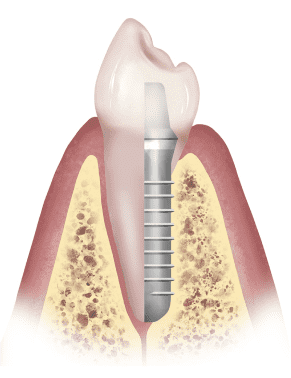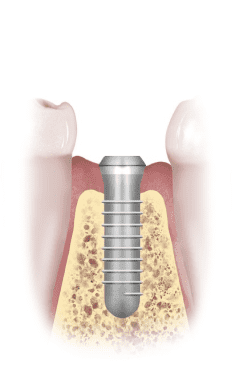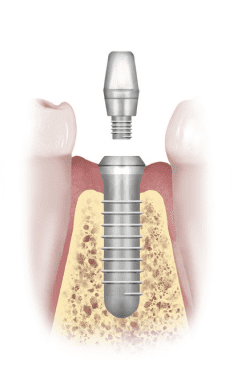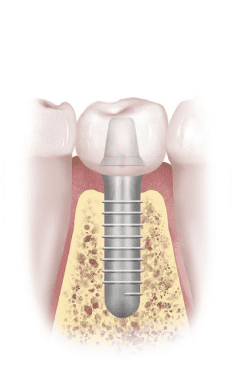
About Dental Implants

Dental implants have revolutionized tooth replacement over the past three decades, offering patients better choices for restoring their smiles and replacing missing teeth. Patients can now have replacement teeth that look, feel and function like natural teeth.
Before dental implants became the standard of care, the only option for people missing all of their teeth was a set of dentures. Patients who lost one or a few teeth had to choose between wearing a removable appliance and cutting down other teeth to support a bridge.
Since dental implants function as substitute tooth roots, missing teeth can be replaced without involving the surrounding teeth. Dental Implants also preserve the bone that normally melts away when a tooth is lost or removed.
Dental Implants Are the Preferred Method of Tooth Replacement
Our oral surgeons will recommend dental implant treatment because it is not only the standard of care, but it also the preferred method of tooth replacement.
- Dental implant treatment is the only option that prevents the bone resorption/deterioration that occurs when a tooth is lost or removed.
- Dental implant treatment is the only option that preserves the adjacent teeth, as opposed to cutting them down to place a bridge or hooking a partial denture to them.
- Dental implants have by far the best long-term success rates of any treatment option for tooth replacement, which has been documented literature for over four decades.
- Dental implants are designed to last a lifetime. They preserve bone and do not compromise the long-term health of adjacent teeth. As a result, dental implant treatment is the most cost-effective option long-term.
Benefits of Dental Implants
Facial Structures Are Maintained. When a tooth is lost or removed, the bone that previously surrounded the tooth root resorbs, or melts away. When a dental implant is used to replace the tooth root, the jaw retains its shape, and the smile retains its natural appearance. Implant-supported replacement teeth will prevent the shrinkage of the jaws and the appearance of a collapsed face for people who are missing all of their natural teeth.
Surrounding Teeth Are Preserved. Tooth-supported bridges require cutting the adjacent teeth down into pegs, and partial dentures hook onto the adjacent teeth. Both of these options compromise the long-term health of your teeth. With dental implants, it is not necessary to involve or damage the adjacent natural teeth.
Natural Appearance Is Restored. Dental implants were developed to replicate the anatomy of natural teeth. They also preserve bone and gum tissue to maintain the natural appearance of the smile. When a surgeon places an implant in the precise position, the ideal foundation is provided for a restorative dentist to create a beautiful replacement tooth that looks like a natural tooth.
Designed To Last a Lifetime. Since dental implants are designed to last a lifetime, the long-term success rate is much better than any other treatment option. Clinical research demonstrates a success rate for dental implants over 95%. From a practice standpoint, this means that dental implant treatment rarely needs to be replaced compared to other options that must be replaced every 5 to 10 years.
For more information about the benefits of dental implants visit The Dental Implant Guide.
The Treatment Process
If the tooth to be replaced has not yet been removed, the first procedure is surgical removal of the tooth. If your surgeon determines that you do not have sufficient bone for a dental implant, you will need a bone graft in the site where the implant will be placed. In some cases, implant placement can be completed immediately following tooth removal and bone grafting. In other cases, the implant will be placed several weeks after the surgical removal of the tooth and placement of a bone graft.

Implant Placement. Your surgeon will utilize a gentle technique to prepare the surgical site and place the dental implant in the proper position. A small cover screw will then be attached to the implant. A temporary replacement tooth (or set of teeth) will usually be inserted following surgery. For a period of several weeks to a few months following surgery, the implant will be left undisturbed to allow the bone to remodel around the implant.

Abutment Attachment. Your surgeon will utilize a gentle technique to prepare the surgical site and place the dental implant in the proper position. A small cover screw will then be attached to the implant. A temporary replacement tooth (or set of teeth) will usually be inserted following surgery. For a period of several weeks to a few months following surgery, the implant will be left undisturbed to allow the bone to remodel around the implant.

Replacement Teeth. The final phase of treatment is designing and fabricating the final replacement crown, bridge or set of teeth. Your dentist will take impressions of your teeth and the abutments and send them to a dental laboratory or technician, to fabricate the replacement teeth. Your dentist will also determine the best shade and shape to match your natural teeth. Once the lab technician has fabricated your new teeth, your dentist will attach them to the abutments, which is usually the final step in the treatment process.
 Redondo & Manhattan Beach: 310-375-0514 |
Redondo & Manhattan Beach: 310-375-0514 | 